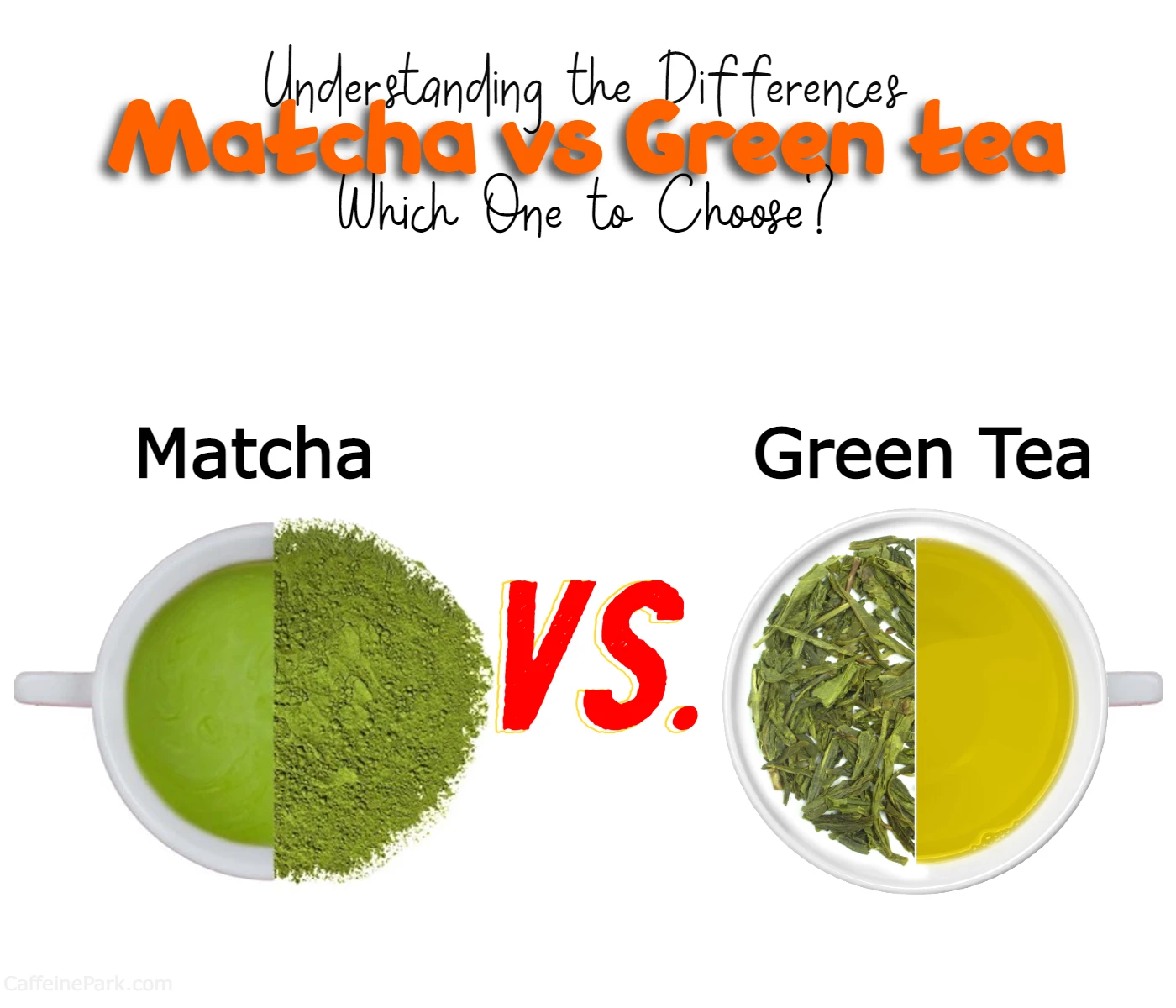Matcha vs Green tea

Are you a tea lover? If so, you’ve probably heard of both green tea and matcha. These two beverages have become increasingly popular in recent years, thanks to their many health benefits and delicious taste. But have you ever wondered what the difference is between the two? In this blog post, we’ll explore the differences between green tea and matcha, so you can make an informed decision about which one to choose.
Whether you’re looking for a healthy beverage to incorporate into your daily routine, or just love the taste of tea, understanding the differences between green tea and matcha is important. While both are made from the Camellia sinensis plant, the way they are prepared and consumed can have a big impact on their flavor and nutritional value.
So, whether you’re a long-time green tea drinker or a newcomer to the world of matcha, keep reading to learn more about the differences between these two popular beverages. By the end of this blog post, you’ll have a better understanding of the unique qualities of green tea and matcha, and be able to choose the one that best suits your tastes and health goals.
Here is a quick chart outlining some of the main differences between green tea and matcha:
| Difference | Green Tea | Matcha |
|---|---|---|
| Preparation Method | Steeping tea leaves in hot water | Whisking a fine powder into hot water |
| Antioxidant Content | High | Very high |
| Caffeine Content | Moderate | High |
| Flavor | Fresh, vegetal, slightly sweet and grassy | Rich, smooth, slightly sweet and vegetal |
| Appearance | Light yellow-green to deep green | Bright green |
| Uses | Brewing as tea, cooking, and baking | Tea ceremonies, baking, smoothies, soups, and sauces |
This chart highlights some of the key differences between green tea and matcha, including how they are prepared, their antioxidant and caffeine content, flavor, appearance, and uses. While both are healthy beverages, understanding these differences can help you choose the one that best suits your tastes and health goals.
Differences between Green Tea and Matcha
Two popular types of tea are matcha and green tea. While they may seem similar at first glance, there are actually some significant differences between the two.
What is Matcha?
Matcha is a type of green tea that is made from shade-grown tea leaves. The tea leaves are ground into a fine powder, which is then whisked with hot water to create a frothy, bright green tea. Matcha has been a staple of Japanese culture for centuries, and it is often used in traditional tea ceremonies.
The Flavor of Matcha
One of the things that sets matcha apart from other types of tea is its unique flavor. Matcha has a rich, smooth taste that is slightly sweet and vegetal. Because the tea is made from ground tea leaves, it has a stronger flavor than traditional steeped tea. Some people describe the flavor of matcha as grassy or earthy, while others find it to be slightly bitter. Overall, the flavor of matcha is quite distinct and may take some getting used to.
The Health Benefits of Matcha
Matcha is often touted for its health benefits. Because the tea is made from whole tea leaves, it contains a higher concentration of antioxidants than traditional steeped tea. Antioxidants are important for protecting your cells from damage caused by free radicals, which can lead to chronic diseases like cancer and heart disease.
In addition to antioxidants, matcha also contains a type of amino acid called L-theanine. L-theanine is known for its calming effects and can help to reduce stress and anxiety. This is why many people choose to drink matcha as a natural alternative to coffee.
Matcha is also thought to be beneficial for weight loss. Because the tea is made from whole tea leaves, it contains a higher concentration of catechins than traditional steeped tea. Catechins are a type of antioxidant that has been shown to boost metabolism and promote fat loss.
What is Green Tea?
Green tea is a type of tea that is made from the leaves of the Camellia sinensis plant. The leaves are steamed or pan-fried to stop the oxidation process, which gives the tea its characteristic green color. Green tea has been a popular beverage in China and Japan for centuries, and it is now enjoyed all over the world.
The Flavor of Green Tea
Like matcha, green tea has a unique flavor that sets it apart from other types of tea. Green tea has a fresh, vegetal taste that is slightly sweet and grassy. The flavor of green tea can vary depending on how it is brewed and where the tea leaves come from. Some types of green tea have a more nutty or floral flavor, while others are more earthy or smoky.
The Health Benefits of Green Tea
Green tea is often praised for its health benefits. Like matcha, it contains a high concentration of antioxidants that can help to protect your cells from damage. Green tea is also thought to be beneficial for heart health. Studies have shown that drinking green tea can help to lower cholesterol levels and reduce the risk of heart disease.
In addition to its antioxidant properties, green tea also contains caffeine. While not as high as the caffeine content in coffee, green tea can still provide a nice energy boost. The caffeine in green tea is also thought to help with weight loss by boosting metabolism and promoting fat loss.
Now that we’ve covered the basics of matcha and green tea, let’s take a closer look at the differences between the two.
Preparation Method
One of the biggest differences between matcha and green tea is the way they are prepared. Matcha is made by whisking a fine powder into hot water. This means that you are consuming the entire tea leaf, which is why matcha has a higher concentration of antioxidants and other nutrients.
Green tea, on the other hand, is typically brewed by steeping tea leaves in hot water. While this still results in a healthy beverage, the concentration of antioxidants and nutrients may be lower than in matcha.
Caffeine Content
While both matcha and green tea contain caffeine, the amount can vary depending on the type and how it is prepared. Matcha (64mg per 8fl oz) generally contains more caffeine than Green tea (20mg to 50mg per 8 fl oz), as you are consuming the entire tea leaf. However, the caffeine in matcha is thought to have a more calming effect thanks to the presence of L-theanine.
Flavor
As we mentioned earlier, both matcha and green tea have distinct flavors. Matcha has a rich, smooth taste that is slightly sweet and vegetal, while green tea has a fresh, vegetal taste that is slightly sweet and grassy. Some people find the taste of matcha to be stronger than green tea, while others find the opposite to be true.
Appearance
Another noticeable difference between matcha and green tea is their appearance. Matcha has a bright green color, thanks to the shade-grown tea leaves that are used to make it. Green tea, on the other hand, can range in color from a light yellow-green to a deep green, depending on the type and how it is brewed.
Uses
Matcha is often used in traditional Japanese tea ceremonies, but it can also be used in a variety of other ways. For example, matcha powder can be used as an ingredient in baking, smoothies, and even savory dishes like soups and sauces.
Green tea is also versatile and can be enjoyed in a variety of ways. In addition to being brewed as a hot or iced tea, green tea can also be used in cooking and baking.
Conclusion
In summary, matcha and green tea are both delicious and healthy beverages with distinct flavors and preparation methods. Matcha is made by whisking a fine powder into hot water, while green tea is typically brewed by steeping tea leaves. Matcha has a higher concentration of antioxidants and other nutrients, but green tea is still a healthy choice. Whether you prefer matcha or green tea, both are great options for staying hydrated and enjoying a wide range of health benefits.
FAQs
The main difference is in the preparation method. Green tea is made by steeping tea leaves in hot water, while matcha is made by whisking a fine powder into hot water.
Yes, matcha has a very high antioxidant content compared to green tea. This is because when you drink matcha, you are consuming the entire tea leaf, rather than just the brewed water.
Matcha has a higher caffeine content than green tea, but the caffeine in matcha is released more slowly into the bloodstream, resulting in a more gradual and sustained energy boost.
Yes, they have distinct flavors. Green tea has a fresh, vegetal taste with slight sweetness and grassy notes, while matcha has a rich, smooth flavor with slight sweetness and vegetal notes.
Yes, while both can be brewed as tea, green tea is also commonly used in cooking and baking, while matcha is often used in traditional tea ceremonies, as well as in smoothies, soups, and sauces.
Read More:
Source:
- National Center for Complementary and Integrative Health – This organization provides information on complementary health approaches, including herbal products like green tea and matcha. Their website offers a summary of the current research on the health benefits and potential risks of green tea here: https://www.nccih.nih.gov/health/green-tea, and on matcha here: https://www.nccih.nih.gov/health/matcha-green-tea.
- Harvard Health Publishing – This website provides reliable health information, including an article on the potential health benefits of green tea, such as reducing the risk of cardiovascular disease and certain cancers: https://www.health.harvard.edu/heart-health/brewing-evidence-for-teas-heart-benefits.
- The Tea Association of the USA – This website provides information on tea, including the health benefits of green tea and matcha. You can find their article on green tea here: https://www.teausa.com/14655/health-benefits-of-green-tea, and their article on matcha here: https://www.teausa.com/15417/matcha-green-tea.





